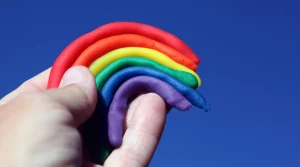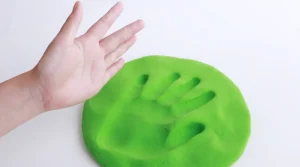
What Is the Science Behind Playdough? Uncover the Chemistry
What makes playdough soft, stretchy, and long-lasting? Explore the chemistry and physics behind this classic sensory material in a fun way.
#1 Toys Manufacturer in China. WhatsApp: +86 180-0088-4063. Email: [email protected]
#1 Toys Manufacturer in China. WhatsApp: +86 180-0088-4063. Email: [email protected]

Playdough has come a long way since its humble beginnings. Early recipes used simple materials like flour, water, and salt. But today, modern playdough formulations incorporate advanced materials that improve texture, safety, and even environmental impact.
>> Top 5 Playdough Sets for Creative Play
Polymers are a key component in modern playdough, helping create the soft, moldable texture that people love. These substances are long chains of molecules that give the playdough its flexibility and resilience.
Without polymers, playdough would lack the stretch and consistency that make it such a popular choice for arts, therapy, and education.
Several polymers can be found in today’s playdough formulations.
One of the most common is polyvinyl alcohol (PVA), which acts as a binder and thickener. It helps playdough keep its shape while remaining pliable. Some playdough also contains glycerin, a polymer that adds moisture, keeping the material from drying out quickly.
Another frequently used polymer is starch, often derived from plants like corn or potatoes. Starch adds bulk and improves the dough’s elasticity, making it easier to mold. It’s commonly used because it is non-toxic and affordable, fitting well with safety and budget concerns.
Modern playdough can include both synthetic and natural polymers, each with unique characteristics.
However, natural polymers may be less predictable, leading to variations in texture and durability. Balancing these factors is important in creating the ideal modern playdough.
Polymers greatly influence how modern playdough feels and behaves.
For example, increasing the amount of glycerin can make the dough softer and more stretchable, while adding more starch can make it firmer. The right mix of polymers ensures a balance between softness and durability, allowing for a pleasant tactile experience.
The way polymers interact with other ingredients, like water or oils, also affects playdough’s overall feel.
In some cases, polymers can trap moisture, keeping the dough fresh for longer periods. This interaction is crucial in modern formulations where playdough is expected to last longer and perform better than traditional recipes.
Modern playdough formulations increasingly incorporate eco-friendly materials, aiming to minimize environmental impact. Sustainable playdough not only considers safety but also uses ingredients that break down naturally over time.
Biodegradable materials in playdough often include plant-based ingredients like cornstarch, wheat flour, and potato starch. Some formulations also use vegetable-based oils instead of mineral oils to enhance texture and moisture retention.
To make modern playdough more sustainable, manufacturers replace non-renewable ingredients with alternatives derived from plants or other natural sources.
For example, switching from petrochemical-based oils to vegetable oils reduces the reliance on fossil fuels. Similarly, using biodegradable fillers like ground rice husk instead of plastic-based fillers helps make playdough less harmful to the environment.
These changes also extend to packaging, with many companies opting for recyclable or compostable materials. Sustainable packaging helps reduce the environmental footprint of playdough products, aligning with broader goals of reducing waste.
Creating eco-friendly playdough poses certain challenges. One major issue is achieving the same texture and durability found in traditional formulations.
Plant-based ingredients can sometimes lead to inconsistent results, making it difficult to produce a reliable product. Additionally, biodegradable materials may have shorter shelf lives, which could limit playdough’s usability over time.
Cost is another factor. Sourcing sustainable materials can be more expensive, which might affect pricing.
However, ongoing research and innovations aim to close this gap, making sustainable playdough more accessible without compromising on quality.
Modern playdough formulations often include various additives to improve sensory play. These additives enhance the tactile, visual, and olfactory experiences, making playdough more engaging.
Scented playdough has gained popularity in recent years. Common scents, like lavender and vanilla, can promote relaxation and focus.
Research suggests that aromas can trigger memories and emotions, enhancing the overall sensory experience.
For instance, citrus scents are often uplifting and energizing. The right scent can transform playdough into a multi-sensory adventure, making it more appealing and immersive.
Microbeads and textured additives contribute to the tactile experience of modern playdough. These tiny, colorful beads create a pleasing crunch when kneaded, adding an extra layer of fun.
Textured additives, like sand or rice, can make playdough feel grainy or rough. This variety in texture can inspire creativity and exploration, allowing users to discover different sensations as they mold and shape the dough.
Color-changing components in playdough rely on temperature-sensitive dyes or pigments. These materials react to heat, changing color as they are manipulated.
For example, a blue playdough may turn pink when warmed by hands. This interactive feature not only captivates users but also introduces concepts of thermochromism.
By engaging with color-changing playdough, users can learn about science in a fun and playful way. This blend of art and science highlights the innovative approaches in modern playdough formulations.
In the realm of modern playdough, safety is a top priority. Manufacturers are increasingly focused on innovative ingredients that ensure their products are safe for users.
Safety standards and certifications are crucial in the production of playdough.
Organizations like ASTM (American Society for Testing and Materials) and EN71 (European Standard) set rigorous testing protocols to ensure safety. These standards evaluate various factors, including non-toxicity, flammability, and age appropriateness.
Products that meet these guidelines often display certifications, assuring consumers of their safety. This is especially important for manufacturers aiming to build trust with retailers and consumers in a competitive market.
Hypoallergenic ingredients play a significant role in modern playdough formulations. These materials are designed to reduce the risk of allergic reactions.
For example, many brands now use gluten-free flour or alternative starches, making their products safe for individuals with gluten sensitivities. The use of hypoallergenic components not only broadens the market reach but also fosters inclusivity.
By choosing hypoallergenic playdough, users can enjoy creative play without worry, ensuring a safe experience for all.
The use of non-toxic dyes and colorants is another key advancement in modern playdough.
This shift toward safer colorants reflects a broader trend in toy manufacturing, prioritizing health and sustainability in product design.
Modern playdough formulations focus on enhancing elasticity and stretchability. These qualities are essential for creating an engaging and enjoyable play experience.
By incorporating specific materials and additives, manufacturers can develop playdough that stretches and snaps back, making it more versatile for various creative activities.
Certain materials are key to improving playdough’s elasticity.
Together, these ingredients can significantly enhance the playdough’s ability to return to its original shape after being stretched, making it more fun and interactive for users.
When comparing modern playdough to other elastic toys like slime or putty, there are notable differences. While all three share qualities of stretchiness and pliability, their textures and properties can vary significantly.
| Feature | Modern Playdough | Slime | Putty |
|---|---|---|---|
| Texture | Smooth and pliable | Sticky and stretchy | Firm and moldable |
| Stretchability | High, returns to shape easily | Very high, can stretch far | Moderate, holds shape well |
| Ease of Use | Easy to shape, non-sticky | Can be messy, may stick to surfaces | Easy to manipulate, less sticky |
| Additives Used | Glycerin, xanthan gum, polymers | Borax, glue, various colors | Silicone, boric acid |
| Best for | Creative molding and shaping | Interactive play, sensory fun | Sculpting and modeling |
| Storage | Can be stored in airtight containers | Requires careful storage to avoid drying | Durable, less prone to drying out |
Modern playdough has evolved beyond just a creative medium. It now includes functional additives that enhance educational experiences. These ingredients not only engage children but also promote learning through play.
Magnetic particles are a game-changer in modern playdough formulations. By adding these tiny particles, playdough can attract magnets, creating fun and interactive learning experiences.
Children can shape the playdough into various forms and then use magnets to make them move. This activity teaches basic principles of magnetism while enhancing fine motor skills.
For example, a child might create a simple vehicle and see how it can roll along a surface when a magnet is nearby. This hands-on learning makes science engaging and memorable.
Glow-in-the-dark materials bring an exciting visual element to modern playdough. When children play with this special dough, they can create glowing shapes that light up in the dark. This feature not only captures their attention but also introduces concepts of light and energy.
For instance, kids can craft stars and planets, creating their own nighttime scene. This encourages imaginative play while teaching them about astronomy and the properties of light.
Moreover, the glow-in-the-dark aspect helps with spatial awareness and sensory exploration in a fun way.
Conductive additives in playdough are paving the way for STEM (Science, Technology, Engineering, and Mathematics) education. By incorporating materials like graphite or metal particles, modern playdough can conduct electricity.
Through this process, they learn about electrical currents, circuits, and conductivity. Such hands-on projects demystify complex concepts, making them accessible and fun.
In the world of modern playdough, the choice between water-based and oil-based formulations plays a crucial role. Each type has its own set of characteristics that can affect the sensory experience and usability.
| Aspect | Water-Based Playdough | Oil-Based Playdough |
|---|---|---|
| Composition | Primarily made from water, flour, and natural ingredients | Contains oil, which enhances texture and durability |
| Texture | Soft and pliable, smooth for easy shaping | Smoother texture; often more durable |
| Drying Time | Dries out quickly if exposed to air | More resistant to drying out |
| Safety | Non-toxic and eco-friendly, safe for younger children | Generally safe but may require more care |
| Clean-Up | Easier to clean up, less residue | Can leave a residue, more challenging to clean |
| Vibrancy of Colors | Colors may fade more quickly | Colors are typically more vibrant and long-lasting |
| Best For | Younger children and quick, casual play | Extended play sessions and educational settings |
| Storage Requirements | Needs airtight containers to prevent drying | Less sensitive to storage conditions |
By modifying its components, manufacturers can create formulations that cater to specific needs.
Therapeutic playdough often requires unique textures and colors. For instance, softer playdough may help with fine motor skills for children with developmental challenges.
Adding calming colors like blue or green can enhance the soothing effect during therapy sessions.
Research shows that sensory experiences can significantly impact emotional well-being (Smith et al., 2020). Manufacturers can adjust the formulations based on feedback from therapists, ensuring that modern playdough serves as a tool for healing.
Different age groups have varying needs when it comes to playdough.
Customizing the playdough for specific age ranges ensures that each group enjoys the experience while developing their skills. This focus on age-appropriate design fosters creativity and learning in a fun way.
In educational settings, custom additives can enhance playdough’s functionality. For example, magnetic particles can turn playdough into a hands-on learning tool for science lessons. Students can explore magnetism while shaping their creations.
Additionally, incorporating glow-in-the-dark materials can make learning about light and colors more engaging.
By adding these unique components, modern playdough formulations can support educational goals while making learning exciting. Custom educational kits bridge the gap between fun and learning, capturing students’ interest and enhancing retention.
the evolution of modern playdough formulations showcases the integration of advanced materials that enhance sensory experiences, safety, and educational value.
Customizable components allow for therapeutic benefits and age-appropriate designs, making playdough a versatile tool for learning and creativity.
Modern playdough often includes flour, water, salt, and various additives like vegetable oils and preservatives. Manufacturers are increasingly using hypoallergenic and non-toxic ingredients to ensure safety for children. Additionally, many formulations incorporate sensory elements, such as scents or textures, to enhance the play experience.
When selecting playdough for educational purposes, look for options with vibrant colors and customizable textures. Playdough that incorporates interactive features, such as magnetic particles or glow-in-the-dark components, can enhance learning. Additionally, ensure that the playdough is non-toxic and compliant with safety standards to promote safe play for children.
Yes, modern playdough can be beneficial for therapeutic activities. Its tactile nature encourages sensory exploration, which is helpful for children with sensory processing disorders. Specific formulations can be tailored to provide calming effects or improve fine motor skills. Always consult with a professional for guidance on using playdough in therapy.
Water-based playdough is typically softer and easier to clean up, making it ideal for young children. It often dries out quickly, so proper storage is essential. In contrast, oil-based playdough tends to be more durable and retains moisture better, making it suitable for extended play. The choice depends on the desired use and specific age group.
To keep playdough fresh, store it in an airtight container in a cool, dry place. Avoid exposing it to heat or direct sunlight, as these can dry it out. For added protection, consider wrapping the playdough in plastic wrap before placing it in a container. Proper storage helps maintain its texture and usability for a longer time.
More Related...

What makes playdough soft, stretchy, and long-lasting? Explore the chemistry and physics behind this classic sensory material in a fun way.

Mixing playdough and slime: science, textures, and creative fun for kids. Learn what happens when these sensory materials come together!

Maximize your playdough and air dry clay’s freshness with easy storage tips and tricks that keep them soft and ready to use.

Playdough is a good craft toy, especially suitable for children aged 3+ to develop hands-on skills. Now let’s make a cute caterpillar craft.

Our team will answer your inquiries within 48 hours.
Copyright © 2025 GuangDong AKIA Technology Co,. Ltd. All Rights Reserved